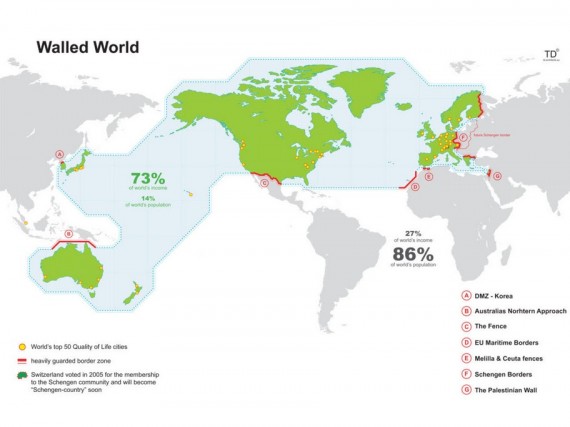Map Of The Day
This map (click to enlarge) is an interesting depiction of what is essentially the area containing the world’s Top 50 cities as measured by quality of life. What interested me is the extent to which most of the conflict areas in the world also happens to be areas where this “super-developed” world butts up against other parts of the planet.







They missed the wall between Saudi Arabia (developed, more or less) and Yemen (still aiming at the 14th C.). The wall does not run the length of the entire border, but exists in areas that see the most frequent illegal immigration/smuggling, i.e., in the KSA’s southwest.
There’s a non-trivial overlap between this and Tom Barnett’s The Pentagon’s New Map. Tom characterizes the “Walled World” as “the Core” and most of the rest as “the Gap”. China, India, a few others he calls “near Core”.
Since when has the US- Mexico border qualified as a “heavy guarded border zone” Twelve year olds regularly cross that line.
Did I miss the joke somewhere?
@Dave Schuler: Structural international relations scholars (yes, they are by and large socialists) have been using the core/periphery distinction between the global North and South for decades now. Cool map.
Any map that says Fairbanks AK or Anchorage AK or Yellowknife NW Territories are among the top 50 cities in the world….
Really Doug, (and everyone else here) do you ever actually look and see? Read and understand?
I am not sure exactly what they are trying to say, but I look at that map and read “Anchorage is a better city than Moscow/Cairo/Riyadh/all the UAE/Santiago/Buenos Aires/ Rio de Janerio/ etc ad nauseum.” Anchorage isn’t even a cow town, it is a moose town.
@OzarkHillbilly:
I don’t see Fairbanks, Anchorage or Yellowknife as marked with the yellow dots above …
Oh, look it is a map of where there is the rule of law in regards to property rights, especially the right to profit from an idea, i.e., patent law.
It’s easier if you just read the review for The Mystery of Capital: Why Capitalism Triumphs in the West and Fails Everywhere Else by Herman de Soto
But not to worry, efforts are already underway to undermine those attributes that raised mankind, even many in the outside area, above fighting for survival and permitted time for far to many to engage in navel gazing, i.e., the industrial and innovation revolutions, exploitation of mechanical energy and the rule of law.